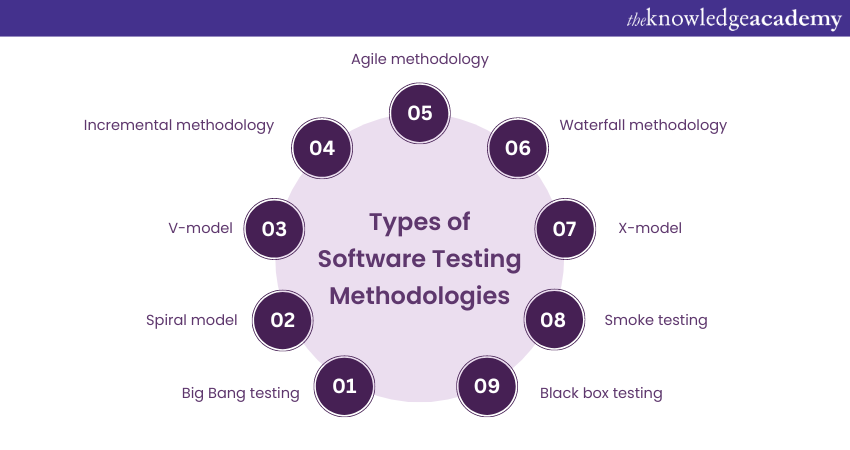We may not have the course you’re looking for. If you enquire or give us a call on 01344203999 and speak to our training experts, we may still be able to help with your training requirements.
Training Outcomes Within Your Budget!
We ensure quality, budget-alignment, and timely delivery by our expert instructors.

In this ever-evolving world of Software Development, ensuring the quality and reliability of applications is paramount. This is where the Software Testing Methodologies come into play. Software Testing Methodologies are the strategies, processes, or environments used to test. To deliver high-quality, safe, secure, and reliable software systems. They are vital in identifying defects, improving software performance, and delivering exceptional user service experiences.
According to Global Market Insights, the global Software Testing industry in 2022 was valued at 35 billion GBP. This market is expected to grow even more substantially in the coming years. Read this complete blog for the deep understanding about what are the various Software Testing Methodologies, its importance and types.
Table of Contents
1) What is Software Testing Methodologies?
2) Software Testing Methodologies: Importance
3) Types of Software Testing Methodologies
4) How do I choose a Software Methodology?
5) Conclusion
What is Software Testing Methodologies?
Software Testing examines software to find discrepancies between actual and desired circumstances and assess the program’s characteristics. Through this procedure, a Software Tester validates and confirms that a piece of Software or an application performs as intended by the company. To ensure the program compiles with all necessary specifications, the system or its components are tested using various Software Testing Techniques per the company's requirements.
By running this into the system, the Tester may find any flaws, omissions, or discrepancies between the intended needs and the actual requirements. Software Developers, Project Managers, end users and System Engineers are the ones who can use such methodologies to improve the quality, safety, and security of implanted software and make informed decisions.

Importance of Software Testing Methodologies
Software Testing is one of the most vital parts of the Software Development Life Cycle (SDLC). Software applications these days have become more complicated and yet connected. One has to test them on so many different devices and platforms before rolling it out. This is why having a strong testing approach is important.
Following thorough Software Testing Methodologies help you meet the requirements set for it. It can perform well in any given situations. It can do all these while being user- friendly and secure.
If you are not using the desired methods to develop and test modern software, projects will cost you more than your actual budget. It will also take a longer time to finish and won’t meet the desired purpose.
Get certified with our ISTQB Software Testing Foundation Course today!
Types of Software Testing Methodologies
Software Testing is one of the most vital parts of the Software Development Life Cycle. The following are the different types of Software Testing Methodologies:

Agile methodology
Agile methodologies, like Scrum and Kanban, emphasise iterative and incremental development. Testing is integrated throughout development, prompting collaboration and faster feedback loops. Once the project is completed, the entire application is tested. The Agile paradigm reduces risk in the development process since each member knows the entire technical ecosystem. A seasoned Project Manager can make rapid choices based on these outcomes. Let's look at the advantages and disadvantages of this methodology:
a) Advantages: Changes can be made at any time in the system to adhere to the project's actual needs and minimise the risk factors involved in any project.
b) Disadvantages: All stakeholders, including the client and the software development and test teams, are under immense time pressure because of continuous client involvement in this stage.
Step into the elite circle of Software Testing experts! With our Software Testing Black Belt Course, transform your QA capabilities and lead with precision
Waterfall methodology
The traditional Waterfall model involves a sequential development phase, where each phase must be completed before moving to the next. Testing is conducted at the end of the development process, leading to delays in identifying defects and making rectifications. Small projects frequently adopt the waterfall approach since it has fewer processes and participants to manage, which can result in quick project completion. However, defects discovered later in the development process may increase the cost of fixing them. Let's look at the advantages and disadvantages of this methodology:
a) Advantages: This approach is simple, understandable, and practical. Due to the rigour of the model, each phase has clear deliverables and a review procedure making it simple to manage. This model processes and completes steps one at a time, making it effective for smaller projects with specific needs.
b) Disadvantages: It is quite challenging to go back and alter things once the application is in the testing stage. This methodology's high Risk and uncertainty make it unsuitable for projects with higher demands.
Prepare for success with top Software Testing Interview Questions - Start your journey now!
Incremental methodology
The incremental model in Software Development divides requirements into several independent cycle modules. Each module in this methodology undergoes the steps of requirements, design, implementation, and testing. This methodology is used when the project requirements are very high and the development team has a lot of buffer time. The following are the advantages and disadvantages of this methodology:
a) Advantages: The incremental model offers flexibility in the development process due to each iteration's independent creation and testing. As a result, it will be simpler to adjust or update without impacting the overall project.
b) Disadvantages: Due to each iteration's distinct creation and testing, the incremental model might be more expensive than other development methods.
Explore essential Software Testing Principles for superior product quality. Strengthen your expertise and ensure reliable software today!
V-model
This model is an extension of the Waterfall model, where each development stage has a corresponding test phase. It establishes a clear relationship between development and testing activities. In Software Testing, the V model helps give a sequential, systematic, and visual depiction of the Software Development Life Cycle (SDLC) process. The V indicates the development flow at each testing phase before moving on to the following step. The following are its pros and cons:
a) Advantages: Before coding, testing activities such as planning and development tests occur. This simple and convenient methodology saves a tonne of time and offers a better likelihood of success than any other model. It works effectively for smaller projects with clearly defined criteria.
b) Disadvantages: It is one of the least flexible and most unyielding Software Testing Methodologies. The test documentation must be updated every time there are modifications.
Gear up for excellence in QA! Grasp the essentials with our Software Testing Green Belt Course.
X-model
This Software Testing and Development model focuses on component-based Software Development. It is a method used to increase reusability while creating component-based software using either already existing or brand-new components. Due to time and financial restrictions, component-based software making is increasingly employed in Software Development.
The cost and duration of Software Development are getting harder to meet. Applications of high standards and competence that meet user’s demands also become crucial. Therefore, most Software Development companies are increasingly concentrating on using reuse methods, like the X model, to cut down on Software Development costs and meet project deadlines. Let's look at its advantages and disadvantages:
a) Advantages: The x model has a simple structure to understand with maximum output result. This model does not require strict supervision, making it one of the most efficient Software Testing Methodologies.
b) Disadvantages: The most significant disadvantage of the X model is that it is based on many assumptions that may not be correct, resulting in poor decision-making.
Dive deep into Software Testing Fundamentals for robust software performance. Build a solid foundation for your testing expertise today!
Spiral model
The Spiral model combines iterative development with risk assessment. Each iteration involves planning, risk analysis, engineering, testing, and evaluation, ensuring continuous improvement. The following are its advantages and disadvantages:
a) Advantages: In the Spiral framework, changes can be made at any stage of work, making it one of the most flexible methodologies to use. Deployment is also more agile and faster compared to other models.
b) Disadvantages: It works best only for large projects and assignments as protocols need to be strictly followed in this model to reach the best outcomes.
Curious about What is Automation Testing? Discover its benefits and tools now!
Big Bang Testing
This informal approach involves testing the application without detailed planning or predefined test cases. It is suitable for small projects or when time is limited. The following are its benefits and limitations:
a) Advantages: The Big Bang testing needs little to no planning in advance because all modules are tested simultaneously, saving the organisations a great deal of time and money.
b) Disadvantages: Since the entire system is being evaluated at once and any of the affected modules may have been the culprit, it is difficult to pinpoint the flaws. This model is time-consuming and works best with smaller projects.
Advance your career with the ISTQB Advanced Level Test Analyst course! Gain expert skills, certification, and stand out in the testing field!
Smoke testing
Also known as Build Verification Testing, Smoke Testing validates the stability of the software's core functionalities before conducting more extensive testing. Let's look at its advantages and disadvantages:
a) Advantages: The smoke testing model helps find the bugs in the early testing phase requiring very few cases.
b) Disadvantages: Detailed testing cannot be expected in this model, which makes it suitable only for smaller projects.
Black box testing
Testers assess the software's external behaviour without knowing its internal structure in this method. It includes techniques like Equivalence Partitioning, Boundary Value Analysis, and more.
a) Advantages: Testing skills are not necessary for this Software Testing methodology. It can also be done by outsourced Testers, making it one of the most flexible methods.
b) Disadvantages: It is difficult to understand the root cause once the test is failed, leading to a high possibility of performing the same test again. This can dramatically increase time and cost issues.
How do I choose a Software Methodology?
Choosing a Software Methodology depends on various factors, such as
a) What does the client want?
b) The type of the project
c) Duration of the work.
In some cases, the testing and development go hand in hand while in other cases, the testing is done once the product is built.
a) Many companies are shifting from old-fashioned software development methods like V-models and Waterfall to Agile methodologies which is proved to have yielded good results.
b) Even though Agile methodology is famous and popular, it has its own shortcomings.
c) These shortcomings include poor feedback, lack of test coverage and skipping important tests.
Want to know the Software Tester Salary range? Click here for insights & trends!
Conclusion
Software Testing Methodologies are essential for ensuring that software programmes are reliable and high quality. Development teams may find and fix errors at different phases of the SDLC by using various strategies and integration. Each approach has certain benefits and meets the Testing requirements. It is crucial to strike a balance between these techniques to produce a reliable and error-free software product specific to the project’s needs resulting in higher user satisfaction and successful software deployments.
Drive excellence, and automate success! Elevate your QA game with our Software Testing and Automation Training. Streamline, optimise, and lead the future of Software Testing.







 Top Rated Course
Top Rated Course



 If you wish to make any changes to your course, please
If you wish to make any changes to your course, please


